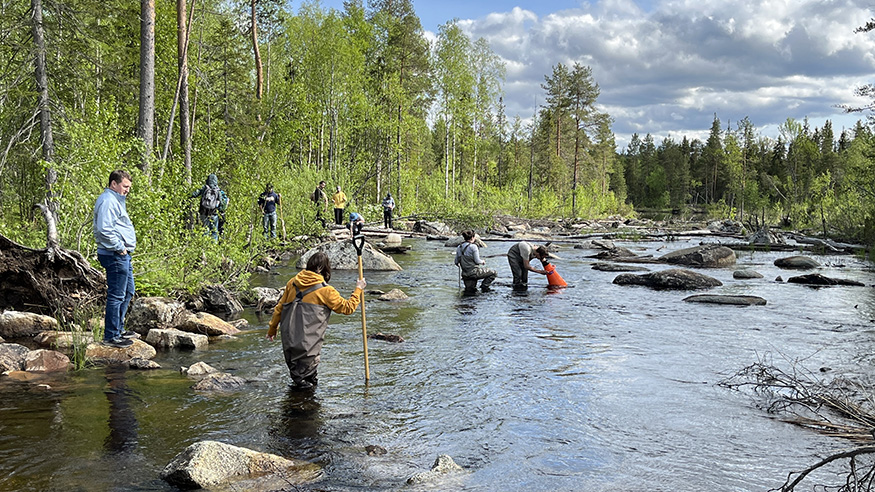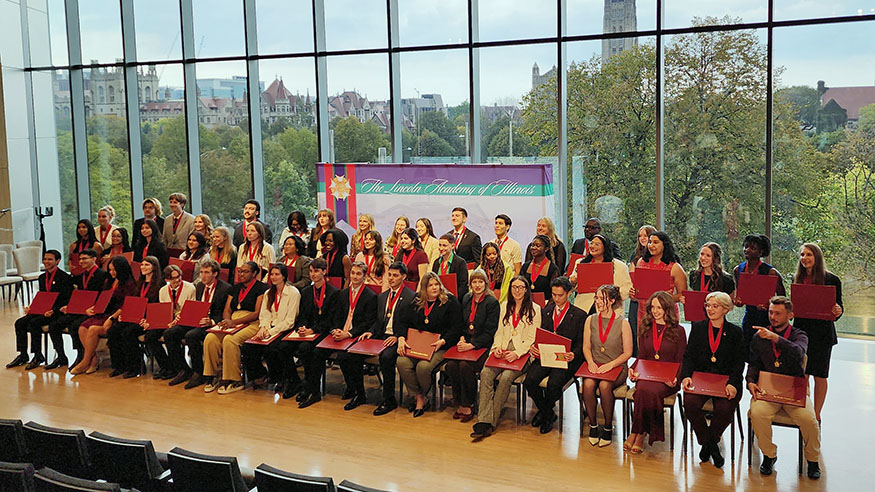Center for Polar Studies
The Center for Polar Studies promotes and supports polar research and scholarship at Augustana and in the broader academic community.
Established in 2009, the center addresses topics such as polar ecosystems, polar earth history, global warming, atmospheric studies, glaciology and meteorology. Future topics may include polar history and the politics of polar regions.
The center will support polar research on and off campus for faculty members and students as funding becomes available. These opportunities may include:
- Supporting both faculty and student research
- Developing and publishing scholarly work
- Presenting research at conferences
- Creating laboratory research assistantships for students
- Supporting research travel and field work
- Sponsoring summer fellowships for students
Polar Center Advisory Board
Jennifer Burnham, Augustana College, director
Kurt Burnham, president and CEO, High Arctic Institute
Anders Carlson, University of Wisconsin, Madison
Edith Taylor, emeritus, University of Kansas
James Collinson, Ohio State University, emeritus
Nathan Smith, Natural History Museum of Los Angeles County; University of Southern California
William Hammer, Augustana College, emeritus
Center activities
Director Jennifer Burnham's doctoral research focused on the distribution of organic carbon in the soils of northwest Greenland, and the implications of carbon cycling in the Arctic on global climate change.
Her current research is centered around the biogeography of seabird colonies on remote islands in northwest Greenland and the impacts that global climate change and anthropogenic pollution (primarily mercury) may have on them. She also utilizes GIS (geographic information systems) to analyze the migratory pathways of arctic-breeding birds fitted with geolocators (light loggers) to document previously unknown winter ranges.
In 2008, a joint research project between Augustana College and the High Arctic Institute was initiated. This project is designed to bring Augustana students to northwest Greenland to assist with joint research projects. In some years students will collect their own data to be used in their senior research projects. Students have been involved in non-fieldwork research projects as well, including GIS analysis of geolocator data.
The High Arctic Institute (HAI) is a non-profit conservation and research organization that focuses on the study and conservation of birds in Greenland. Founded in 2007 by board member Kurt Burnham the HAI is continuing research on peregrine falcon and gyrfalcon populations in Greenland that was initially begun in 1972.
The HAI has expanded the work to also include monitoring populations of seabirds, waterfowl, and other bird species in northwest Greenland. Current research focuses on the likely effects of climate change on these species and their response, including changes in nesting chronology, breeding ranges, and density.
William Hammer has an active National Science Foundation grant that supports his Antarctic research with students on campus and also collaborative research with Peter Makovicky and Nathan Smith, Field Museum of Natural History in Chicago and the University of Chicago, Chris Sidor, University of Washington and Philip Currie, University of Alberta. Details regarding these research projects, including recent publications, can be found at the Transantarctic Vertebrate Paleontology Project .
Hammer is at work on two new writing projects, a description of the first pterosaur from Antarctica and a book for the general public entitled: Dinosaurs on Ice: Mesozoic Life of Antarctica. As part of this project he has a recent Augustana graduate, Jodi Larson, working in his research lab.
Hammer, Makovicky, Smith and Sidor have new collaborative NSF proposals pending for three additional years of support . These grants would fund a new field expedition in 2010. They also would support both undergraduate and graduate student participation in the proposed projects.
Hammer recently was chosen by the NSF to be one of 10 Antarctic researchers involved in a new public outreach program sponsored by the Office of Polar Programs entitled: Conversations from Antarctica: From Dinosaurs to Black Holes. His duties will involve public presentations at weekend workshops around the country.
Events and lectures
In 2025 the Augustana Center for Polar Studies sponsored a two-week study abroad course called Geography of the Arctic. Fourteen students participated in a semester-long course on campus in the spring taught by Dr. Jennifer Burnham, Professor of Geography. They then travelled to northern Sweden for two weeks, joined by Dr. Mark Safstrom, Associate Professor of Scandinavian Studies. Highlights of the trip included travel to Kiruna, Abisko National Park, Laponia UNESCO World Heritage region, Jokkmokk, and Luleå. Themes of the course covered resource extraction, green energy/technology, tourism, Sami indigenous culture, climate change, geopolitics, military defense, urban infrastructure, and more.
2018 lectures
Unfreezing the Arctic: Historical Perspectives on Arctic Futures
Dr. Andrew Stuhl, Bucknell University
11-29-18
Indigenous Rights in the Arctic Under Threat
Aaju Peter, Iqaluit, Canada
4-17-19
2017 event
Art Above 66° 33'
In collaboration with the Augustana Teaching Museum of Art
Artists: Michael Bartalos, Lisa Goren, Jonathan Harris, Morten Hilmer, Ben Huff, Cheryl Leonard, Andrea Polli, Kananginak Pootoogook, Kakulu Saggiaktok, Oona Stern, and William Stout.
(video)
2016 lectures
The Other Arctic: Knowledge, Creativity and the New Frontier
Dr. Andrey Petrov of the University of Northern Iowa
7 p.m. April 7, 2016
John Deere Planetarium and Carl Gamble Observatory, John Deere Lecture Hall
(video)
Glaciation During the Late Paleozoic Ice Age
Dr. John L. Isbell, University of Wisconsin-Milwaukee
7 p.m. Feb. 4, 2016
Hanson Hall, 102
(video)
2015 lecture
The secret life of Antarctic sand: Tales from the world's largest ice sheet
Dr. Kathy Licht of Indiana University-Purdue University
7 p.m. March 12, 2015
John Deere Lecture Hall
(video)
Arctic meltdown? Geologic perspectives on polar climate change
Dr. Yarrow Axford,
Northwestern University
7 p.m. April 16, 2015
Hanson Hall, Room 102
(video)
2014 lectures
The Hidden Diversity of Life and the Greatest Mass Extinction of All Time
Dr. Stephen Hasiotis,
Kansas University
7 p.m. March 27, 2014
Hanson Hall, Room 102
(video)
Monitoring Polar Ice Using Satellites, Airplanes, and a Robot
Dr. Lora Koenig
Glaciologist, NASA Goddard Space Flight Center
7 p.m., Jan. 23, 2014
John Deere Lecture Hall
(video)
2013 lecture
Greenland Ice Climate Sensitivity
Dr. Jason Box,
Byrd Polar Research Center, Ohio State University
7 p.m., Jan. 31, 2013
Hanson Hall of Science 102, Augustana
(video)
2012 lecture
Tracking Long-Term Ice Sheet Retreat in West Antarctica
Dr. Claire Todd,
Pacific Lutheran University
7 p.m., April 26, 2012
Hanson Hall of Science 102, Augustana
2011 lecture
Adaptive Significance of White Plumage Color in High Arctic Gyrfalcons
Dr. Jeff Johnson,
University of North Texas
7 p.m., April 28, 2011
John Deere Planetarium
Lecture Hall, Augustana
2009-2010 lectures
From Giant Amphibians to Dinosaurs: Antarctica during the Age of Reptiles
Inaugural lecture
Dr. William Hammer, Augustana College
Dec. 9, 2009 (video)
Ice Fishing for Neutrinos: Scientists are Melting Holes in the Bottom of the Earth
Dr. Francis Halzen, University of Wisconsin-Madison, Jan. 21, 2010
Archaeological Investigations in Northwest Greenland
Dr. Christyann Darwent,
University of California, Davis, Feb. 4, 2010
The Hydrologic Cycle in a Changing Arctic
Dr. Tamlin Pavelsky
University of North Carolina, March 18, 2010
The Lush Vegetation of Antarctica: Understanding Ancient Climate from Fossil Plants
Dr. Edith Taylor
University of Kansas
April 15, 2010







